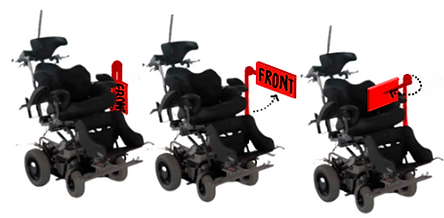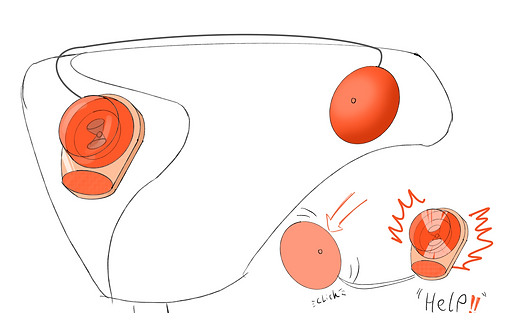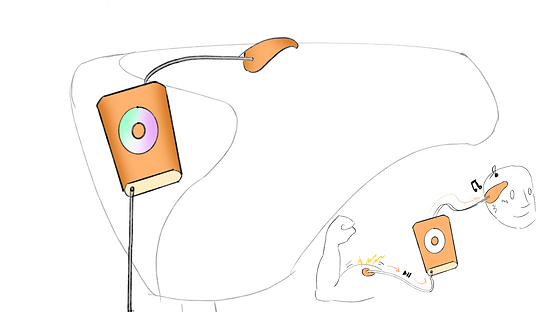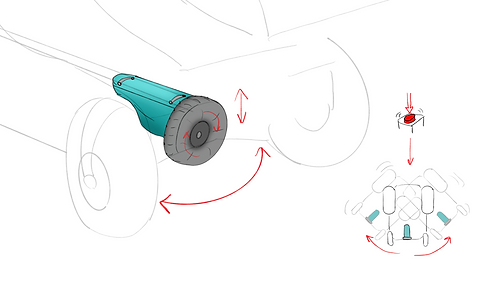Concept development
COMPONENT research
BUTTON FUNCTIONS:
After the ideation, separate research was carried for the different functions the button could have and how it could be activated:
DEADMAN SWITCH
Could be placed behind his back, under his knees or on the side of his arms. The button is only activated once it is released, so in case of emergency Andrei would have to move to release it.
The issue with the system is that it requires considerable strength for the specific movement, which might be a challenge for Andrei, especially in case of distress.
Considerations:
-
The button would have to have an off mode when he leaves the wheelchair, so that it doesn’t activate by accident;
-
Because of the positioning, it would have to be cushioned to be comfortable for Andrei, as he would be pressing it the entire time;
-
To avoid accidental releasings (spasms), it could be placed under both knees and both would have to be released to activate. This would however require considerably more strength.
Pressing Button
A simple pressing button that would be connected to his headpiece. When needed, Andrei would then lean to press it and deliver the signal.
.
Considerations:
-
The optimal position would have to be explored to find what would be easier to press;
-
Different button sizes and shapes could be easier/ harder for Andrei to press;
-
Would limit the space Andrei can rest his head on the headpiece, as part of it would be always occupied by the button.
DISTANCE
SENSOr
The sensor would be able to measure how far Andrei is to it, and then activate it accordingly. This might be a more comfortable way for him to press the button, since it doesn’t involve actively pressing or having something he has to be in contact with all the time.
. Considerations:
-
Can give a wide range of continuous inputs; they would have to be filtered then;
-
Can be also used in combination with regular button to achieve other different inputs/functions;
-
Depending on the sensor, there might be limitations regarding signal output depending on the environment and other stimuli.
OPTIC SENSOR
Instead of pressing a button, the action of Andrei looking toward a component could serve as the action of “pressing”; a sensor or camera programmed to recognize eyes and the direction they are facing would offer an easier method of input for Andrei.
.
Considerations:
-
The component would rely heavily on its coding, making it possibly unreliable, as the software may need specific conditions to be met (e.g. directly facing the camera, being perfectly vertically lined up) to work reliably.
-
While pre-programmed modules may exist, programming such a sensor from scratch would take up a lot of valuable time and effort.
-
More advanced technical parts such as cameras tend to be more expensive than relatively simple components.
ATTACHMENTS:
Together with this, components that would work together with the button were also considered. This would consist of a feedback system for letting the user know when the button is pressed and a way of attaching the button to the wheelchair:
Feedback
-
Vibration system: deliver feedback by vibrating after the button is pressed. Would have to be placed in an area Andrei has sensibility to and where he stays in contact with;
-
Lights: light up when the button is activated. Intelligibility could depend on the environment conditions around;
-
Buzzer: play sound when the button is pressed. One thing to consider is how it affects the people around it, especially others in the daycare if it plays too loudly/ frequently.
CONNECTORS
-
Bolts: using the metal bars and side connections on the wheelchair itself, the button could be attached using bolts. This affects less the headpiece, but makes the button less easily accessible for the larger distance;
-
Velcro: by using velcro it would be possible to make the button more modular and easily detachable. It also could be decorated so that it could display Andrei’s personality through it.
-
Magnets: various components could easily be detached and swapped out for other ones more suited for the situation, makes the assembly more versatile. Depending on the strength of the magnets, it might not be able to hold up any part though.
concepts
Concept 1
Tobi activation: When the button located in the headpiece is pressed, Tobi will be opened in (see image), which means Andrei is ready to use Tobi.
In addition to this, the Tobii could also open in a circular way, being more inviting.
-
Tobi folded in: to fold Tobi away a button on the opposite side of the headpiece is pressed (or a different function on the previous button like double pressing, but this could be complicated for Andrei).
From this concept Andrei gets more independence by being able to decide when he wants to turn on and off the Tobii in order to communicate. The movement of the Tobi could be studied to be smooth, flipping or inviting. This will evoke a certain feeling of amusement rather than pity for people in a wheelchair.
The Button could be attached to the headpiece with velcro so we can assure that it is tight enough and doesn’t come loose. But also so it can work on other wheelchairs and other parts (Andrei has been sitting in different wheelchairs over the years).
The location of the button has to be determined together with Andrei, as well as looking into what feels comfortable.


Concept 2
In order to make sure Andrei has a solution to when he encounters an emergency, a button could be implemented onto his wheelchair. This security button would also feature a speaker on the back of his wheelchair, that could have an alarm or recording; a pamphlet with instructions on what to do if Andrei needs help.

.png)
Concept 3
Since Andrei is such a big fan of music, we want to offer a system where he can listen to music a bit more independently.
Music is downloaded onto a mp3 player or a device that can have audios downloaded on it, and with a pressure sensor on a muscle- when that muscle is flexed- he can skip, pause or resume a song.
The music could be heard through special headphones that function by sending vibrations through the skull instead of putting directly into his ear, in order to let him hear when these are not in use. (not fully necessary but this gives him more independence because he does not need to ask to remove these).
Concept 4
Offering more types of movements on the wheelchair that can be controlled by Andrei. This could be done by adding a third wheel to the chair and with a pair of buttons controlled by Andrei, the wheelchair could move in some angles enabling to see better his surroundings.
It could also have a few modes like traveling/outside mode, that offers bigger turn angles since the outside is way bigger than the interior of a building for instance.
The buttons could be implemented into the headpiece.

chosen concept
After the codesign sessions a chosen concept is formed. The original idea of a button developed by the thesis student is replaced based on the session with Andrei, in which it was noticed that he had considerably more ease with moving his eyes than moving his head to press a button. Based on this, it is decided to develop a “button” , a sensor that would activate when Andrei lookes at it. This is be placed close to his head, and the connection to the wheelchair should be modular so that it can be moved when required. This is to allow clearance for a caretaker when needed, to give Andrei flexibility on where it is more comfortable to look on a certain day, and to allow changes in positioning between wheelchairs (as other prototypes are being constructed).
To do this electronic components would have to be integrated with a flexible arm, that would then have to be connected in a not permanent way to the wheelchair.
.png)
For the electronic part of the concept/prototype, three main ideas are developed:
-
Person Sensor: using the person sensor from Useful Sensors, it is possible to program it to recognize Andrei’s eyes/ face or to check when he is facing the sensor. That is then be the input to activate the function of the “button”;
-
Gyroscope: by using a gyroscope it is possible to measure Andrei’s head movement around the xyz-axis. A determined change in position could then initiate the “button.” For this to be possible, the gyroscope would have to be attached to his head;
-
Face recognition software: by connecting a camera and a microcontroller module, it would be possible to take pictures of Andrei and run face/ eye recognition on it. If Andrei is facing the camera when the picture is taken, the software would be able to recognize it and start the “button.” The working is similar to the Person Sensor but in separate components.
From these, the Person Sensor is selected to be developed further, as its pre-programmed properties would allow us to achieve a working prototype quicker than the other options and would result in a concept more comfortable for Andrei, compared to the gyroscope or something he would have to wear on his head.
A back-up plan would be programming image recognition by the project group themselves, which makes it able to adjust the code so it only recognizes eyes instead of a whole face.




